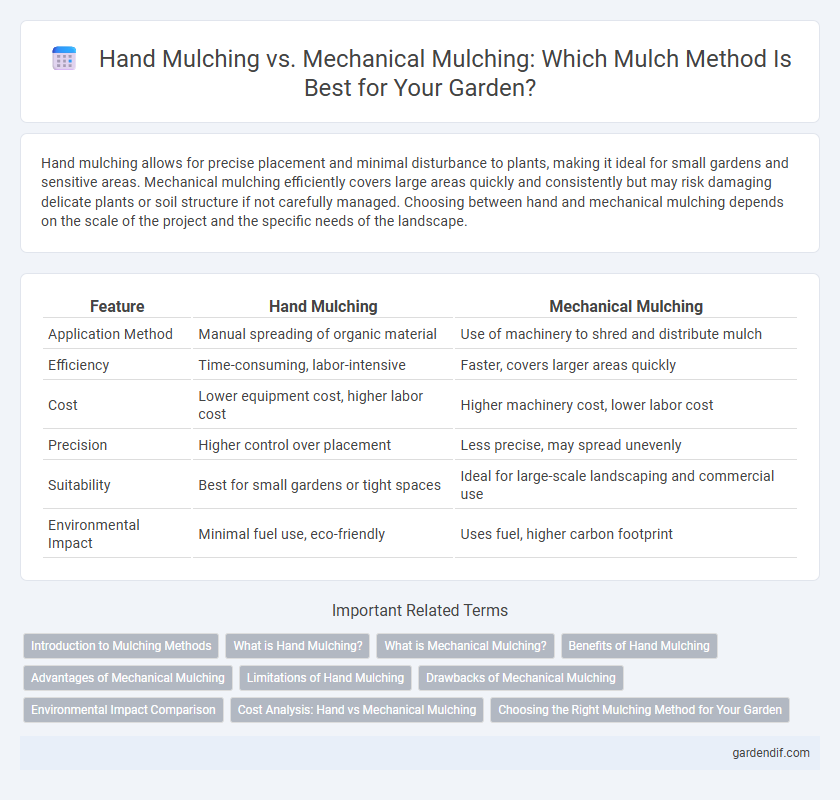
Hand Mulching vs Mechanical Mulching Illustration
Hand mulching allows for precise placement and minimal disturbance to plants, making it ideal for small gardens and sensitive areas. Mechanical mulching efficiently covers large areas quickly and consistently but may risk damaging delicate plants or soil structure if not carefully managed. Choosing between hand and mechanical mulching depends on the scale of the project and the specific needs of the landscape.
Table of Comparison
| Feature | Hand Mulching | Mechanical Mulching |
|---|---|---|
| Application Method | Manual spreading of organic material | Use of machinery to shred and distribute mulch |
| Efficiency | Time-consuming, labor-intensive | Faster, covers larger areas quickly |
| Cost | Lower equipment cost, higher labor cost | Higher machinery cost, lower labor cost |
| Precision | Higher control over placement | Less precise, may spread unevenly |
| Suitability | Best for small gardens or tight spaces | Ideal for large-scale landscaping and commercial use |
| Environmental Impact | Minimal fuel use, eco-friendly | Uses fuel, higher carbon footprint |
Introduction to Mulching Methods
Hand mulching involves manually spreading organic materials like leaves, straw, or compost around plants, offering precise application and minimal soil disturbance. Mechanical mulching uses machinery such as chippers or mulchers to shred and distribute mulch quickly over larger areas, increasing efficiency but potentially causing soil compaction. Both methods improve soil moisture retention, temperature regulation, and weed suppression while differing in labor intensity and scale suitability.
What is Hand Mulching?
Hand mulching involves manually applying organic or inorganic materials like wood chips, leaves, or straw around plants to conserve moisture, regulate soil temperature, and suppress weeds. This method allows precise placement and minimal soil disturbance, making it ideal for small gardens or sensitive plants. Hand mulching promotes healthier root systems and improves soil structure through gradual decomposition of organic matter.
What is Mechanical Mulching?
Mechanical mulching involves the use of specialized machinery, such as mulching mowers or forestry mulchers, to shred vegetation and organic material directly on-site. This method efficiently processes large areas by breaking down branches, brush, and other plant debris into fine mulch, promoting soil health and reducing waste removal costs. Mechanical mulching is favored for its speed, consistency, and ability to handle tough or dense vegetation compared to manual hand mulching.
Benefits of Hand Mulching
Hand mulching offers precise application around plant bases, reducing soil disturbance and preserving root integrity, which enhances plant health and growth. It enables the use of organic materials like wood chips and leaves, improving soil moisture retention and nutrient content naturally. This method also minimizes equipment costs and environmental impact by avoiding fuel consumption and emissions associated with mechanical mulching.
Advantages of Mechanical Mulching
Mechanical mulching provides efficient ground coverage over large areas, significantly reducing labor time compared to hand mulching. It promotes consistent mulch thickness, improving soil moisture retention and weed suppression more effectively. This method is especially advantageous in commercial agriculture and large landscaping projects due to its scalability and precision.
Limitations of Hand Mulching
Hand mulching is labor-intensive and time-consuming, limiting its efficiency for large-scale landscaping or agricultural projects. It is less effective in uniformly spreading mulch, resulting in inconsistent coverage and potential weed growth. Physical strain on workers and slower application rates constrain productivity compared to mechanical mulching methods.
Drawbacks of Mechanical Mulching
Mechanical mulching often leads to soil compaction and disruption of beneficial microbial activity, negatively impacting soil health and plant growth. The heavy machinery can damage tree roots and create uneven mulch layers, reducing effectiveness in moisture retention and weed suppression. Higher operational costs and fuel consumption also make mechanical mulching less sustainable compared to hand mulching methods.
Environmental Impact Comparison
Hand mulching minimizes soil disturbance and preserves beneficial microorganisms by applying organic materials gently, promoting better soil health and biodiversity. Mechanical mulching, while efficient for large areas, can compact soil and disrupt habitats, leading to increased carbon emissions and potential loss of soil fertility. Choosing hand mulching over mechanical methods supports sustainable gardening practices and reduces environmental degradation.
Cost Analysis: Hand vs Mechanical Mulching
Hand mulching typically incurs higher labor costs due to the intensive manual effort required, making it less cost-effective for large areas. Mechanical mulching involves upfront investment in equipment and fuel but significantly reduces labor expenses, providing a more economical solution for extensive mulch applications. Cost analysis favors mechanical mulching for large-scale projects, whereas hand mulching remains viable for small-scale or precision mulching tasks.
Choosing the Right Mulching Method for Your Garden
Hand mulching offers precise application and is ideal for small gardens or delicate plants, ensuring minimal soil disturbance and targeted nutrient distribution. Mechanical mulching suits larger areas with dense vegetation, providing faster coverage and effective weed control but requires investment in equipment and can compact soil if overused. Selecting the optimal mulching method depends on garden size, plant sensitivity, budget, and desired efficiency in soil health improvement and moisture retention.
Hand Mulching vs Mechanical Mulching Infographic

 gardendif.com
gardendif.com